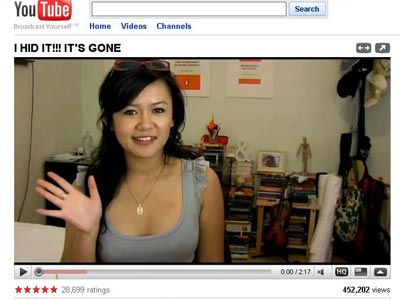Enjoy.
It would be hard to find anyone under the age of twenty who hasn’t uploaded at least one video to the social media site Youtube. I have at least 10 videos online myself including one of two friends and I miming along to a popular 90s song. No, I will not share this rather embarrassing video with you. There are copious amounts of videos online ranging from music to movie re-enactments and comedy to cute children and has been a platform for finding fame. The TED Talks Youtube video (2009) states that technology is a form of social capital and “innovation can happen anywhere”. Teen singing sensation Justin Bieber and the “Will it blend?” guy, most notable for blending an iPhone, are just two examples of Clay Shirky’s philosophy.

Answer: yes it will.
Natalie Tran, now 24, became an online vlogging (video blogging) personality after she found fame through a debate with an American on Australia’s much loved spread, Vegemite. As stated on The Age Blog, this caught the attention of A Current Affair and was featured on a segment called the “Vegemite Wars”. From this, viewers flocked to her Youtube page to view her tri-weekly comedy filled videos and from then on, as the saying goes, the rest is history. Sternberg (2011) believes that a negative of do-it-yourself (DIY) media is that “most generated content is not especially creative or sophisticated”. In the case of Natalie Tran, this is definitely not true. While some may call it procrastination, I prefer to think of my time spent watching her witty and talented videos as research. When it comes to positives of DIY media, Sternberg (2011) states that this requires media organisations to “rethink old assumptions about what it means to consume media”. After building up quite a following, one organisation heeded Natalie’s online fame and realised the potential they had to promote their products.

Youtube sensation: Natalie Tran
Lonely Planet (2011a) was started by two adventurous globetrotters with a passion for travel over 30 years ago. Within a week of starting up the company, 1500 books were sold and now they have everything from a vast array of travel books, both hard and electronic copies to a reputable website filled with everything found in there books and so much more. So, what does Natalie Tran have to do with Lonely Planet? To quote the vlogger herself, “Lonely Planet thought it would be a good idea to get me out of the house to see the world now that I've finished university” (2011b), and she has done exactly that. For four months she traveled nearly every continent on the globe and posted weekly videos and blogs on the Lonely Planet website in true Natalie Tran style. In Paris she discussed their weird curbside parking habits, she made breakfast using an iron and a coffee maker in San Francisco and in New York City she consumed an unhealthy amount of hotdogs from various hotdog stands. I think it’s safe to say that Natalie Tran is living the life that many social media graduates would envy. I know I do.

Swimming with the locals
Natalie Tran is a perfect example of how web 2.0 is empowering media users as it “blurs the lines between media audiences and creators” (Sternberg, 2011) or as Bruns (2007) calls them, produsers. It also shows how the relationship between media users and the media industry are changing; in a sense, they’re becoming co-creators and allowing polylogical communication to take place (Harrington, 2011). As Sternberg (2011) explains, audiences and media organisations “collectively contribute to the social, cultural and economic value of media products”. Here we have Lonely Planet, a reputable and well-known travel company, utilising the skills of Natalie Tran, a social media graduate and together creating something entertaining for audiences of both Lonely Planet and Natalie Tran’s Youtube channel.

That shirt couldn't be further from the truth
Now, cast your mind back to our first lecture of this unit for the semester, if you can remember that far back. The first thing we learnt about was Turow’s model of communication and how it was a very straightforward and one-sided means of communicating. Now erase that image because that clearly isn’t the case in today’s world of media and communication. As Olivia King states in her blog post, Are You Calling Cancer? “Advances in technology over the last 50 years have resulted in an exponential change in the way the media is used and delivered.” However, changes in technology are not just seen in the way the media is used and delivered, rather they have allowed for new models and means of communication to take place. Many are honing in on this and a new generation of creative minds is shaping our world.
Instant abs: you'll be a personal trainer in no time
Whether it’s creating a dangerous fad on Facebook or showing the world just how funny you are on Youtube, technological advances have given us a new platform in which to channel this creativity and Natalie Tran is just one out of a handful of people leading the way in how user-generated content is creating opportunities for future media professionals.
No comments:
Post a Comment